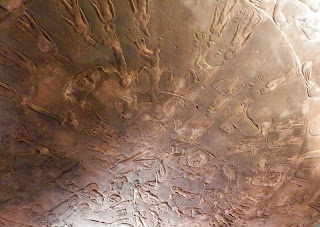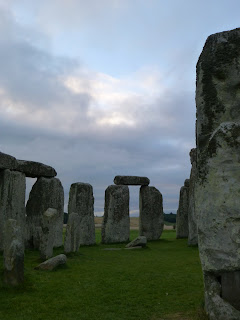Dreaming with the Goddess
The Sleeping Lady, a figurine now held at the Museum of Archaeology in Valletta, Malta, was found in the Main Chamber of the Hal Saflieni Hypogeum (c. 3300-3000 BC). The hypogeum, an UNESCO World Heritage Site, is the only prehistoric underground temple in the world. It is hewn from limestone, and contains several levels, each with its own unique properties and purposes. The chamber walls were washed in red ochre and painted with spirals and circular patterns. One room in particular, the Oracle Room, has remarkable acoustic properties for producing resonance of sounds. It is believed that the some of the rooms were used for religious rites, as the underground chambers symbolized a return to the womb of Mother Earth, from which all life derived.
If the hypogeum was indeed a site of worship and initiation, a place to experience a rebirth, it seems to me that the "Sleeping Lady" is actually not sleeping at all, but dreaming or journeying to an altered state of consciousness. Her fecund form lies in a fetal position, resting in the womb of creation.The added aspect of sound resonance makes me wonder if drums were used to induce a heart-beat like trance state, one that many shamanic traditions employ. Was this the dream initiation of a priestess? The place of ritual magic performed by an oracle as she journeyed to the underworld or the time before birth? And all this took place above the bones of their ancestors.
I love that there was a level that they call a Snake Pit, some two meters deep. Did the journeys revolve around creatures who lived underground and were themselves symbols of rebirth, shedding their skins and emerging anew?
Could the "sleeping women" have been connected with the bee priestesses called Melissae, that were known throughout the Mediterranean. Did they gather to hum in their underground hive? The Melissae were priestesses of the Goddess Demeter, initiates of the chthonian goddess. Was sacred honey used as a tool for divination, or as a vehicle to altered states of consciousness?
All my senses are alive with curiosity. I envision candle light and spiral forms traced by fingertip with red ochre. The sweet taste of honey on my lips, humming and toning growing louder, amplified by the acoustics of the chamber. Libations and dance, invocations to the Goddess of the Womb. Plant medicine or mead with honey trickling its way down the throat, past the throat and into the third eye. The smell of incense curling around and through the chambers. Would they have gathered at their moon time? Traced the spiral with their menstrual blood? Celebrated at new moon or full? Equinox or Soltice? Did their dreams provide the vision and direction of their communities?
As I prepare to visit the hypogeum, I allow myself to prepare for the experience in dreamtime, to anticipate and open to the possibilities of connecting with the energies of the priestesses of old. There are a few spaces left in the tour, if you're interested. For information visit this link.
If the hypogeum was indeed a site of worship and initiation, a place to experience a rebirth, it seems to me that the "Sleeping Lady" is actually not sleeping at all, but dreaming or journeying to an altered state of consciousness. Her fecund form lies in a fetal position, resting in the womb of creation.The added aspect of sound resonance makes me wonder if drums were used to induce a heart-beat like trance state, one that many shamanic traditions employ. Was this the dream initiation of a priestess? The place of ritual magic performed by an oracle as she journeyed to the underworld or the time before birth? And all this took place above the bones of their ancestors.
I love that there was a level that they call a Snake Pit, some two meters deep. Did the journeys revolve around creatures who lived underground and were themselves symbols of rebirth, shedding their skins and emerging anew?
Could the "sleeping women" have been connected with the bee priestesses called Melissae, that were known throughout the Mediterranean. Did they gather to hum in their underground hive? The Melissae were priestesses of the Goddess Demeter, initiates of the chthonian goddess. Was sacred honey used as a tool for divination, or as a vehicle to altered states of consciousness?
All my senses are alive with curiosity. I envision candle light and spiral forms traced by fingertip with red ochre. The sweet taste of honey on my lips, humming and toning growing louder, amplified by the acoustics of the chamber. Libations and dance, invocations to the Goddess of the Womb. Plant medicine or mead with honey trickling its way down the throat, past the throat and into the third eye. The smell of incense curling around and through the chambers. Would they have gathered at their moon time? Traced the spiral with their menstrual blood? Celebrated at new moon or full? Equinox or Soltice? Did their dreams provide the vision and direction of their communities?
As I prepare to visit the hypogeum, I allow myself to prepare for the experience in dreamtime, to anticipate and open to the possibilities of connecting with the energies of the priestesses of old. There are a few spaces left in the tour, if you're interested. For information visit this link.
The
Bugibba Temple, which is preserved in the grounds of the hotel, belongs
to the same category of pre historic monuments as Tarxien and Hagar Qim
in Malta and Ggantija in Gozo. These imposing sanctuaries, erected for
the worship of a deity, which has so far defied a generally acceptable
definition, constitute the outstanding achievement of the Maltese Copper
Age, igs Megalithic architecture. - See more at:
http://www.dolmen.com.mt/the-dolmen-experience.aspx#sthash.dJyMLeSk.dpuf
Bugibba
Temple, which is preserved in the grounds of the hotel, belongs to the
same category of pre historic monuments as Tarxien and Hagar Qim in
Malta and Ggantija in Gozo. These imposing sanctuaries, erected for the
worship of a deity, which has so far defied a generally acceptable
definition, constitute the outstanding achievement of the Maltese Copper
Age, igs Megalithic architecture. - See more at:
http://www.dolmen.com.mt/the-dolmen-experience.aspx#sthash.dJyMLeSk.dpuf
The
Bugibba Temple, which is preserved in the grounds of the hotel, belongs
to the same category of pre historic monuments as Tarxien and Hagar Qim
in Malta and Ggantija in Gozo. These imposing sanctuaries, erected for
the worship of a deity, which has so far defied a generally acceptable
definition, constitute the outstanding achievement of the Maltese Copper
Age, igs Megalithic architecture. - See more at:
http://www.dolmen.com.mt/the-dolmen-experience.aspx#sthash.dJyMLeSk.dpuf



Comments